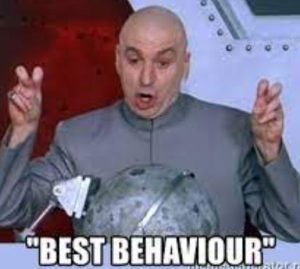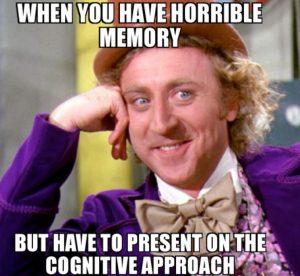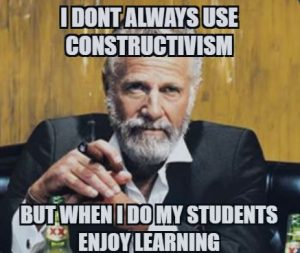Learning Theories – Week 4
To begin with, I think it is important to define what learning entails and how learning occurs to properly do a deep dive into my own teaching philosophy, classroom practice and changes or shifts in my 8.5 years of teaching. Ertmer and Newby define learning in their article Behaviorism, Cognitivism, Constructivism: Comparing Critical Features From an Instructional Design Perspective as “an enduring change in behavior, or in the capacity to behave in a given fashion, which results from practice or other forms of experience.” The Merriam-Webster dictionary breaks down learning into three different definitions:
- The act or experience of one that learns.
- Knowledge or skill acquired buy instruction or study
- Modification of a behavioral tendency by experience (such as exposure to conditioning)
Both of these interpretations of learning outline that the learner is taking part in some sort of instruction or observation and as a result will modify a behavioral behavior accordingly.
To properly answer this question I felt it necessary to seek the answers that Ertmer and Newby pose in their article relating to each learning theory:
- How does learning occur?
- Which factors influence learning?
- What is the role of memory?
- How does transfer occur?
- What types of learning are best explained by the theory?
- What basic assumptions/principles of this theory are relevant to instructional design?
- How should instruction be structured to facilitate learning?

I feel getting the answers to these questions will help provide the necessary information surrounding each learning theory for me to understand each theory more, compare and contras and accurately identify which theory is the driving force behind my teaching philosophy and classroom practice.
Behaviorism
How does learning occur?
This theory equates learning to either the changes in the form or frequency of observable performance. It is accomplished when a proper response is demonstrated following the presentation of a stimulus.
Which factors influence learning?
Although there are multiple factors at play within the Behaviorist theory (learner and environmental), many theorists feel that the environmental conditions are the most important. Further outlined that the environmental factor encompasses the arrangement of the stimuli and the consequences within the environment in which the stimuli is utilized.
What is the role of memory?
Memory is not seen or acknowledged as a critical component by behaviorists with more emphasis given to the creation of new habits with forgetting a response attributed to nonuse.
How does transfer occur?
Within the Behaviorism Theory, transfer occurs when the learner is placed in a similar environment to the one where the skill was learned which promotes transfer across the common environment.
What types of learning are best explained by the theory?
Learning that involves the use of instructional cues, practice and reinforcement that are used in building, strengthening and maintaining stimulus response associations. Further described as tasks that involve recalling facts, defining and illustrating concepts, applying explanations and automatically performing a procedure.
What basic assumptions/principles of this theory are relevant to instructional design?
Ertmer and Newby outline specific assumptions/principles have a direct relationship with instructional design:
- Producing observable, measurable and correct behaviors
- Pre Assessments to determine where instruction should begin.
- Scaffolding
- Using rewards to reinforce behaviors.
How should instruction be structured to facilitate learning?
As outlined earlier, this theory is driven by eliciting the proper behavior from a learner following a stimulus. With that said, instruction should be structured in a way that students see the appropriate/correct behavior and are given many opportunities to practice making the proper response.

Cognitivism
How does learning occur?
Learning is geared more towards the changes between states of knowledge vs the search for a proper response that is seen in Behaviorism. These theories focus on the conceptualization of the students’ learning processes and address the issue of how information is received, stored and utilized.
Which factors influence learning?
Cognitivism, like behaviorism, placed the most emphasis on the environment in which the learning is taking place stressing the importance of demonstrations, explanations, examples and ample opportunities to practice and apply skills.
What is the role of memory?.
Cognitivsm places more emphasis and importance on the learners memory and ability to retain and retrieve information. Learning results when information is properly stored in memory in an efficient and organized manner. Inability to retrieve information is said to be due to interference, memory loss or missing or inadequate cues needed to access the information.
How does transfer occur?
Transfer occurs in Cognitivism when the learner is able to apply the knowledge and skills learned in a multitude of contexts, not only the one that the information was acquired in
What types of learning are best explained by the theory?
Due to the increased emphasis placed upon the learners mental structures and memory cognitive theories are more appropriate for tasks and learning where reasoning, problem solving and informational processing are required.
What basic assumptions/principles of this theory are relevant to instructional design?
Ertmer and Newby outline specific assumptions/principles have a direct relationship with instructional design:
- The learner is required to be an active participant in the learning process.
- Learners need to be able to follow procedure.
- Teachers play a crucial role in present information in a manner that learners can process and retain.
- Teachers need to create an environment where students can connect their learning with previously acquired skills.
How should instruction be structured to facilitate learning?
Unlike Behavioral theories where the teachers are required to arrange the learning environment in such a way that elicits the proper response, Cognitive theories require the teacher to make learning meaningful and help learners connect, organize and relate new information to previous.

Constructivism
How does learning occur?
Unlike Behavioral and Cognitive theories where learning is dependent upon the outside world, Constructivist Theories essentially contradict these previous theories in that learning is driven by the learning creating learning based upon interpretation of their learning experiences.
Through the Constructivist lens, learning essentially takes place through experiences where the mind filters data from the learning experiences to create their own unique learning, essentially meaning that humans create meaning rather than acquire it which contrasts what is stated with Behavioral and Cognitive Theories.
Which factors influence learning?
Both learner and environmental factors are crucial for learning to take place through the Constructivist lens. To create learning there is a specific interaction that needs to happen between these factors for knowledge to be acquired. It is important that learning takes place in realistic settings and that the learning tasks be relevant to the learner.
What is the role of memory?
Looking through the Constructivist where knowledge is always under construction, there becomes less of a reliance on memory and more of a continual construction of learning. The emphasis is not on retrieving knowledge rather on creating novel and situation specific understanding through the use of previous knowledge and newly acquired knowledge.
How does transfer occur?
Through this theory, transfer occurs when learners are placed in authentic, engaging, meaningful and challenging contexts where they are forced to create new meaning.
What types of learning are best explained by the theory?
Constructivist approaches to learning and knowledge acquisition are best suited for situations where mastery or advanced knowledge acquisition.
What basic assumptions/principles of this theory are relevant to instructional design?
Ertmer and Newby outline specific assumptions/principles have a direct relationship with instructional design:
- Meaningful and authentic contexts are essential
- Using what is learned in an active manner
- Variety in the learning contexts
- Problem solving skills
- Being able to apply knowledge to multiple contexts.
How should instruction be structured to facilitate learning?
Simply put, instruction within the Constructivists lens is to show students how to construct knowledge through the use of multiple perspectives with the use of collaboration with others.
Ertmer and Newby state in their article(pg. 24), “as one moves along the behaviorist – cognitivist – constructivist continuum, the focus of instruction shifts from teaching to learning, from the passive transfer of facts and routines to the active application of ideas to problems.” This quote resonated with me when thinking about my own practice. As educators, we do this on a daily basis and that all three of these theories are at play daily in some capacity.

In terms of my own classroom and teaching practice, I feel that I draw on aspects of all three of these theories. I feel I use each of these theories in my day to day teaching practice. I rely heavily on Behaviorism to help establish routines and appropriate reactions to specific aspects of the school day. For example, I have trained my students that when they come in first thing in the morning and right after lunch they are expected to be reading, writing or drawing, helping them settle from their outside time during recess. I reinforce the positive behavior with a reward (candy) for those who are on task without prompting…. We are still working on this!
As educators I think it is safe to say that we use the Cognitive and Constructivist Theories as what in terms of instruction and assessment. We present our students with what we hope to be unique, authentic and engaging learning activities to help in the acquisition of new knowledge and skills and as they become more efficient with the skill we present them with an extension or enrichment type activities where they must use knowledge gained from early learning opportunities to create new meaning for themselves. We continue to strive for change and adaptation to our own teaching practices to continue to provide students with meaningful and authentic learning opportunities.
One thing that I think that has shifted or changed, is more of an emphasis on using the behaviorist lens to create routines and procedures although this theory also creeps its way into my classroom instructional repertoire! The use of behavioral tendencies has shifted the most especially since I entered into the Elementary School teaching world. I have found that these students often still need to learn how a school day operates and what behaviors are expected. I realize these behaviors will change from classroom to classroom, but a lot still require knowledge on how to behave in class. I have found that this may still be the case in some High School settings, but these students are quicker to pick up on the appropriate behavior and change accordingly.
Cheers,
Bret
5 thoughts on “Learning Theories – Week 4”
Wow, Bret, thanks for laying this out. I really appreicate how you began with the definitions of learning from the dictionary, I always find this interesting to refer to. I also appreciate that how you seeked answers in relation to Ertmer and Newby. Thinking on these learning theories, I would agree that all three play a role in areas of my teaching. Through different technologies used, lesson plans and conversations, these theories are all inevitably used (without me even realizing, most times!) Moving forward, I think I will be more conscience on the learning that is occuring and HOW that learning is happening. How do you think we can change school so there is not so much of an emphasis on using behavourist lens to create routines and procedures? Is this possible? Looking forward to your thoughts!
Hey Raegyn, thanks for the comment! I was thinking the same thing today at school as I was finishing up this post and watching my students disregard any sort of routines, procedures and expectations that we spent a lot of time developing at the start of the school year using a behaviouralist approach (obviously DID NOT WORK)…..This also made me think there has to be a better way to establish these… I am wondering if there is a way to utilize a constructivist approach for students to establish these routines, procedures and understand expectations….?
It is crazy how easily and quickly student forget all the expectations you spent weeks on weeks establishing. I think that the constructivist way of establishing routines, procedures and understanding of expectations could be done. Having students come together and create their own classroom expectations would be one way to do this. They could use their background knowledge from previous years (for the older grades) and the teacher could provide scaffolding. I also think that classroom points could potentially be an example of this. Having them decide together what would give them the points and what it would be used for. But as I think about this more, it still is touching on behaviourism. Maybe it isn’t something we can completely get away from. I appreicate how organized and well layed out your blog post is. It allowed me to grasp a deeper understanding on this topic. Thanks, Bret!
Thanks for your post Bret. I too use procedures and positive reinforcement to structure my classroom. However, something that bothers me about my own practice is that I might be unintentionally creating compliance rather than actually facilitating learning, which allows my class to run smoothly, but does little to create divergent thinkers. I wonder if by associating the adherence to authority (with various rewards) if I am stifling creativity, or outside the box thinking. I’ve thought sometimes that maybe the way I do things I am teaching students to exist within the current system rather than seeking to change it. I have always found it a tight rope walk between keeping classes under control and allowing students a reasonable amount of freedom.
Great post Bret. It’s interesting to see how similarly we thought about this! I also enjoyed the structure of Ertmer and Newby, particularly with defining what learning entails before going into detail with each of the theories. And to bounce off of Matthew’s comment, I also try and tow the line between compliance and freethinking. While I am a big fan of structure, routine, and clear expectations, I am often fearful of what creativity or personality I may be missing as a result of them.